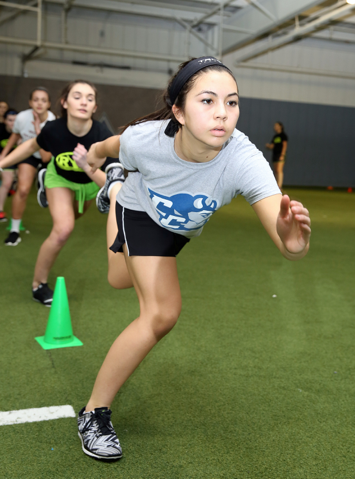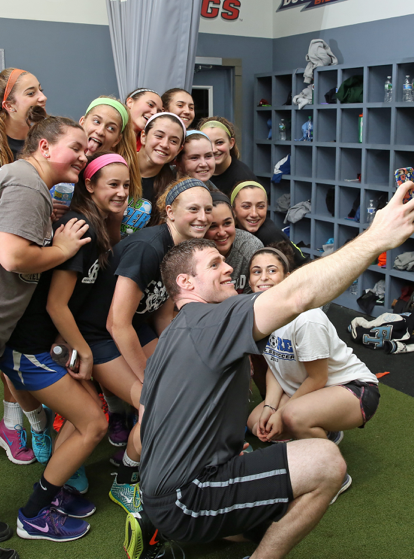3 Tips on Training Today’s Female Athletes
By: Adam Feit & Dan Hitman
Generally speaking, there aren’t (and shouldn’t be) many differences between training male and female athletes.
Every athlete needs to improve the foundational qualities of speed, strength and power. They need to be mobile, stable, and certainly in shape. And most importantly, they need to be healthy so they can produce results when it matters most!
But after five years of operation and 3500 female athletes later, we’ve picked up on a few key training differences that can help you and your athletes reach their potential.
Female Training Tip #1:
Strive For Volume/Density, Not Intensity
This can fall into two different buckets: female athletes and/or youth athletes
After spending most of my career working in college strength and conditioning, I made the switch to the private sector. I soon found myself working with and training primarily youth female athletes.
When I say primarily, I mean like 80% of our clientele.
What I quickly noticed was that our athletes simply didn’t handle the traditional model of progressive overload as well as my college athletes. Forget percentages, readiness questionnaires and velocity tracking. They couldn’t increase their training load week to week and maintain form, speed and most of all, confidence.
Was another 5-10 lbs worth it on our last set; gambling on them failing and shattering their confidence as they began weight training?
Many times I have seen an athlete crush a set at a particular weight. Then, not hit a single rep with five additional pounds added on the following set. Instead of pushing more weight each set, we adapted our training cycles to work on increasing volume throughout set cycles. This form of volume accumulation allows us to still overload the athlete but in a safer manner.
[message_box title=”An example of a four-week squat cycle might look like this:” text=” Week 1: 4×5
Week 2: 4×6
Week 3: 3×8
Week 4: 3×4, 1 open set between 8-10 reps”]
Of course, if the iron is hot, we will strike and increase load with volume, but we have found over the years that by finding a good training weight and asking the athletes to do 1-2 more reps than they did last week versus grabbing a heavier dumbbell goes a long way with long term physical and mental development.
By adding in just a few reps each week, sometimes as little as one to two reps each week, we will increase the overall training load by four to eight reps each month and up to thirty plus reps by the end of the season. This will passively increase their work capacity and help hone other skills such as focus and grit.
Lastly, we have found our female athletes to demonstrate a greater ability to recover between sets much quicker than our male athletes. Since the relative effort is the same, we can’t use the excuse of “Well, male athletes are lifting heavier so they need more time to rest.”
To be quite frank, our male athletes simply need to work harder.
To accommodate our females, most of them will have added sets and reps to accommodate their skill level. This is especially true when we are teaching new movements. A few extra sets of cleans or split squats to drive home the fundamentals beats filler exercises like “abs” any day.
Special: Speed Training – Top End Speed Drills for Female Athletes (Video)
Female Training Tip #2:
Train The Posterior Chain Every Day
 Unfortunately, there are a few things that female athletes have to deal with in their training that their male counterparts don’t have to worry so much about.
Unfortunately, there are a few things that female athletes have to deal with in their training that their male counterparts don’t have to worry so much about.
You know–just your typical quadriceps dominance, anterior pelvic tilt, more lax ligaments, and wider Q angles…
Oh, and up to 9x more likely of tearing an ACL.
No big deal right?
All of these characteristics put them at an increased risk for injury when they attempt to absorb force (i.e. landing from a jump, decelerate, or change direction).
Plus, with an overactive “anterior chain”, our posterior chain of the lower back, glutes and hamstrings remain inactive, thus preventing the body from using its’ preferred muscles to decelerate.
Because of this, we attack the posterior chain everyday at RYPT.
On Day 1:
We focus on executing the hip hinge. It is integral on the Olympic lifts and the basis for any explosive movement including jumps and throws.
- Movements include all types of double and single-legged band, kettlebell, and dumbbell RDLs
On Day 2:
We focus on leg curl variations, working knee flexion while maintaining active hip extension.
- Movements include all types of slide board and Valslide leg curls, partner glute ham raises and lowers.
On Day 3:
We focus on active hip extension. The emphasis is on keeping the spine neutral, heels down and pushing the feet through the floor.
- Movements include all variations of band, medicine ball, dumbbell and barbell hip lifts.
For any type of lower body “knee dominant” training we do, we want to make sure we have an equal amount of “hip dominant” training, keeping a 1:1 if not 1:2 ratio of anterior to posterior exercises. Many of our posterior chain movements follow a higher volume approach. This is to combat all the years of inadequate strength and activation. So, if we were to squat for sets of five, we might be doing RDLs for sets of 8-10.
Female Training Tip #3:
Don’t Neglect Single Leg Training
 For most sports, the much of the game is played on one leg. Besides rowing and Olympic weight lifting, many sports require athletes to push, plant, pivot, and perform on one leg at a time.
For most sports, the much of the game is played on one leg. Besides rowing and Olympic weight lifting, many sports require athletes to push, plant, pivot, and perform on one leg at a time.
Think about running, going up for a layup, stepping into a baseball swing, or shuffling to play defense.
Throughout the years, we’ve noticed that improving our single leg strength transfers to a better double leg strength ratio. The opposite is not always true. Also by training the single leg, we can better address the abd/adductors. This limits the amount of valgus tracking while increasing the stability of the knee.
At RYPT, we use a variety of linear, lateral and rotational split squats and lunges in the warm-up to prepare for loaded movements later in the program. Like our double leg training, we attend to each variety of movement pattern. We do hip and knee dominant, as well as pushing and pulling exercises. The variety of exercise selection exposes athletes to moving in a variety of planes and through many different motions. This also improve their awareness of their body in space. That understanding of how the body moves is helpful when the athlete is faced with a decision or a situation in a game or contest.
On Day 1:
We focus on progressing our athletes into single-legged RDL variations, focusing on their proprioception and force production. This comes towards the end of the workout after we have already performed our major double leg push for the day, which is usually some sort of squat variation.
On Day 2:
We focus on an auxiliary single leg push movements with variations of split squats, rear foot elevated split squats, lunges and step-ups.
On Day 3:
Depending on the level of the athlete and season of the year, we will perform either another double or single leg push exercise as a primary strength movement. For most beginner athletes, we start off with the hex bar deadlift and transition into a loaded barbell split squat or lunge as they get close to their competitive season.
Special: Speed Training – Top End Speed Drills for Female Athletes (Video)
Don’t be responsible for another statistic
More than ever, female athletes are playing sports, training hard, and striving to win a scholarship.
They’re sacrificing quality training time with sports performance coaches like us to play another season of AAU basketball, club soccer and showcase softball.
So we’ve got to do OUR part and educate and empower coaches and parents alike to not only help athletes reach their potential, but also prevent them from LIMITING their potential due to injury. While we cannot prevent all injuries, experience and education have shown us we can certainly have a major hand in preventing many of them due to inadequate strength and body control.
If you’re looking for a complete system for training today’s female athletes, we hope you consider the work we’ve done, the programs we’ve developed and the athletes we have helped–3500 and counting. We’re hoping you can add to that number today.
Thanks for your support!
GET RYPT!
[message_box title=”Check out the entire Training the Female Athlete Blueprint from Adam Feit TODAY!” text=””]

Complete Guide to Training the Female Athlete


0 Comments for “3 Tips on Training Today’s Female Athlete”